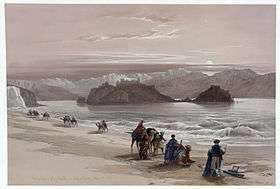Louis Haghe
| Louis Haghe | |
|---|---|
 | |
| Born |
17 March 1806 Tournai, Belgium |
| Died |
9 March 1885 (aged 78) Stockwell, London |
| Known for | lithographic printing |
Louis Haghe (17 March 1806, Tournai, Belgium – 9 March 1885, Surrey) was a lithographer and watercolour artist.
His father and grandfather had practised as architects. Training in his teens in watercolour painting, he found work in the relatively new art of lithography when the first press was set up in Tournai. He visited England to find work, and settled there permanently in 1823.
Together with William Day (1797–1845), around 1830 he formed the partnership Day & Haghe, which became the most famous early Victorian firm of lithographic printing in London.
Day and Haghe created and printed lithographs dealing with a wide range of subjects, such as hunting scenes, architecture, topographical views and genre depictions. They pioneered the new techniques for chromolithography as well as hand-tinted lithographs. After William's death in 1845, the firm became known as 'Day & Son'. They were pioneers in developing the medium of the lithograph printed in colours.
In 1838, Day and Haghe were appointed 'Lithographers to the Queen'. Possibly his most ambitious project was providing 250 images for David Roberts' The Holy Land, Syria, Idumea, Arabia, Egypt & Nubia printed between 1842–9. Roberts praised his skill and artistry, although John Ruskin called it 'forced'.
From the mid-1850s Haghe concentrated more on his watercolours, and gained a reputation for his architectural scenes of northern Europe, with his pictures bought and displayed by the Victoria and Albert Museum. He also painted in oils, which were exhibited at the British Institution. He became president of the New Society of Painters in Water Colours from 1873 to 1884.
Haghe's artistic works were achieved in spite of a deformity in his right hand since birth. He died at Stockwell Road on 9 March 1885 and was buried at West Norwood Cemetery.
His younger brother Charles Haghe (-1888) (also known as Charles Hague) was employed as an assistant at Day and Haghe, and remained there after Louis left.
References
- Michael Twyman, "Haghe, Louis (1806–1885)", Oxford Dictionary of National Biography, Oxford University Press, 2004 accessed 16 Nov 2007
External links


| Wikimedia Commons has media related to Louis Haghe. |
- Catalogue
- A new map of Texas
- Works by or about Louis Haghe in libraries (WorldCat catalog)